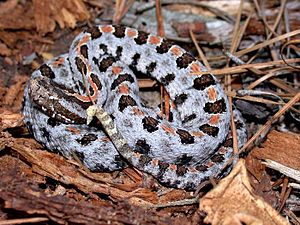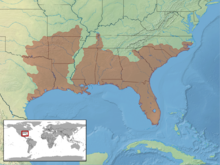Dwarf rattlesnake
| Dwarf rattlesnake | ||||||||||||
|---|---|---|---|---|---|---|---|---|---|---|---|---|

Little Rattlesnake ( Sistrurus miliarius miliaris ) |
||||||||||||
| Systematics | ||||||||||||
|
||||||||||||
| Scientific name | ||||||||||||
| Sistrurus miliarius | ||||||||||||
| ( Linnaeus , 1766) |
The dwarf rattlesnake ( Sistrurus miliarius ) is a species of the genus of the same name, the dwarf rattlesnake ( Sistrurus ), whose distribution area extends in the central United States of America to the southern and southeastern coast of the country.
features
The dwarf rattlesnake reaches an average body length of about 50 centimeters and is rarely up to 70 centimeters long. The tail with the very small tail rattle is very thin. The basic color of the snake is light gray, gray or reddish with a pattern of small, rounded spots on the back, which are usually dark gray. A narrow pink, orange or cinnamon-colored stripe can run through the spots, which originates on the top of the head. There are often other, smaller spots on the flanks.
distribution and habitat
The dwarf rattlesnake is common in an area from the central United States of America to the south and southeast coast of the country including the Florida peninsula .
The snake mainly uses forest areas (pine or pine-oak forests) in the vicinity of bodies of water as a habitat. It often hides under leaves, bark and other parts of plants on the forest floor.
Systematics
The dwarf rattlesnake is currently split into three subspecies:
- S. m. barbouri in Florida, southern Georgia and Alabama, and the extreme southeast of Mississippi ; this species is characterized by fine mottling of the body and head
- S. m. miliaris in North and South Carolina , central Georgia, and Alabama
- S. m. streckeri or western dwarf rattlesnake in the westernmost part of the range up to the Atlantic coast.
Snake venom
The poison of the dwarf rattlesnake corresponds in its basic composition to that of the rattlesnake and like most viper poisons it is hemotoxic, i.e. it destroys blood cells and the walls of the blood vessels. Hemotoxins lead mainly to tissue destruction, internal bleeding and swelling and are very painful, but compared to most neurotoxins they kill less quickly. In contrast to the poisons of the rattlesnakes, those of the dwarf rattlesnakes are far less well researched. The dwarf rattlesnake produces relatively small amounts of venom and has relatively short fangs that do not penetrate very far into the tissue. The effects usually consist of local swelling, pain and general nausea .
literature
- Chris Mattison: Rattlers! - A natural history of rattlesnakes. Blandford, London 1996, ISBN 0-7137-2534-6 , pp. 136-137.
Web links
- Sistrurus miliarius in The Reptile Database
- Sistrurus miliarius inthe IUCN 2013 Red List of Threatened Species . Listed by: Hammerson, GA, 2007. Retrieved September 2, 2013.

